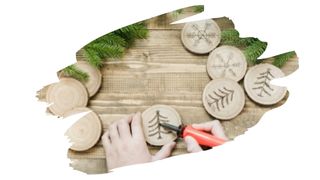Pine wood is affordable, easily accessible, and widely popular as a wood choice for interior decor.
But, while pine makes strong furniture, there are other things you need to think about when it comes to pyrography. Things such as sap content and grain texture, will have a greater impact on your designs than any other characteristic.
So, when it comes to pyrography, is pine wood really worth it?
Well, in this post, you will discover the four key characteristics of a great pyrography timber. You’ll also learn why natural pine wood isn’t the best choice for your wood burning designs — and why kiln-dried pine wood is.

This post may contain affiliate links to products that we receive a commission for (at no additional cost to you). Learn more here.
What Is The Best Kind Of Wood For Pyrography Art?
Well, the best type of wood is one that is both clean burning and a clean canvas. So, as a general rule of thumb, ideal pyrography woods fall under the following four criteria;
1). They Have Light Color Grain
Light color wood grain contrasts very nicely as a backdrop against darker burn lines.
Also, lighter pale grain won’t obscure any intricate shading in your images either.
2). They Have Uniform Grain
This particular point has more to do with the clarity of your images than anything.
If you draw on wood types that have very visible grain lines, (like Oak wood), it will make your art appear faded.
Related Post: Beginners Guide To Reducing Oak Grain Contrast (Explained)
3). They Contain Very Little Tree Sap/Pitch
Wood types that contain lots of resinous tree sap/pitch, (such as Cedar), are a nightmare to burn onto.
First off, excessive tree resins produce an excessive amount of smoke. But, more importantly when it comes to pyrography, they can heat up and bubble over. And if you are burning a drawing that needs nice clean lines, bubbling sap is going to mess with it.
But, if that otherwise sap-saturated wood has been kiln-dried, then this is a different matter.
You see, when we want to reduce the moisture content in wood, we leave it to air-dry for 6-12 months. This is called ‘seasoning’.
Related Post: How To Season Wood (7 Tips)
Now, kiln-drying is a super-heated milling treatment that fast-tracks the process of wood seasoning.
This is done by placing wood into a super-heated kiln oven instead. And it is this high-heat treatment that quickly evaporates away the moisture content inside freshly logged lumber.
Now, one big advantage to kiln drying sap-rich timber, is that this heat-treatment will also evaporate tree sap. So, if a sap-rich wood type has been kiln-dried, then it’ll be fine for wood burning.
Related Post: Are Heat Treated Pallets Safe To Burn As Firewood?
4). They Should Not Contain Toxins Or Poisonous Compounds.
Some types of lumber naturally contain toxic compounds in them. And that means it’s too risky, (for your personal health), to burn them.
And many types of manufactured woods, (such as MDF or Plywood), are saturated with chemical glues that contain Formaldehyde. So they too, should not be used for pyrography.
Related Post: Is Plywood Really A Safe Wood For Pyrography?
In short, only use clean burning non-poisonous timbers for your next wood burning art project.
So What’s The Best Type Of Wood For Pyrography?
The best option for beginners and pros alike is Basswood.
Basswood grows abundantly across the most northern parts of North America. And it is that abundance that makes this lumber so affordable.
But, more than that, it easily meets all of the four criteria for good pyrography timber.
Basswoods pale fine uniform grain is the ideal canvas for your next piece of art. And natural solid Basswood does not contain any toxic compounds that you need worry about.
Related Post: Is Basswood A Good Wood For Pyrography?
But What About Pine Wood? Can You Use Pine Wood For Pyrography Too?
Pine wood, (just like Cedar), contains a lot of tree sap in it. So, this resinous lumber is frustrating to burn into. Especially if you’re working on an image that has a lot of shading.
Having said that, kiln-dried Pine should contain next-to-no tree resins in it. So, this specially treated pine is less likely to give you problems stemming from bubbling resin.
So, if you have some kiln-dried Pine wood, feel free to use it for Pyrography. Otherwise, Pine is better off used for simple practice, but not much else (pyrography-wise).
To Wrap Up, Here Are The 3 Key Takeaways From This Post…
- 1). The ideal type of wood for pyrography art will have light color unobtrusive grain. It will also contain very little tree sap/pitch and contain no toxic compounds.
- 2). Basswood is one of the best woods for wood burning art. Its pale fine grain makes for a fantastic canvas for your images.
- 3). Pine wood is saturated with resinous tree sap. And those tree resins can mess up the clarity of your lines. However, kiln-dried pine wood contains very little sap, so it can be used for pyrography.



